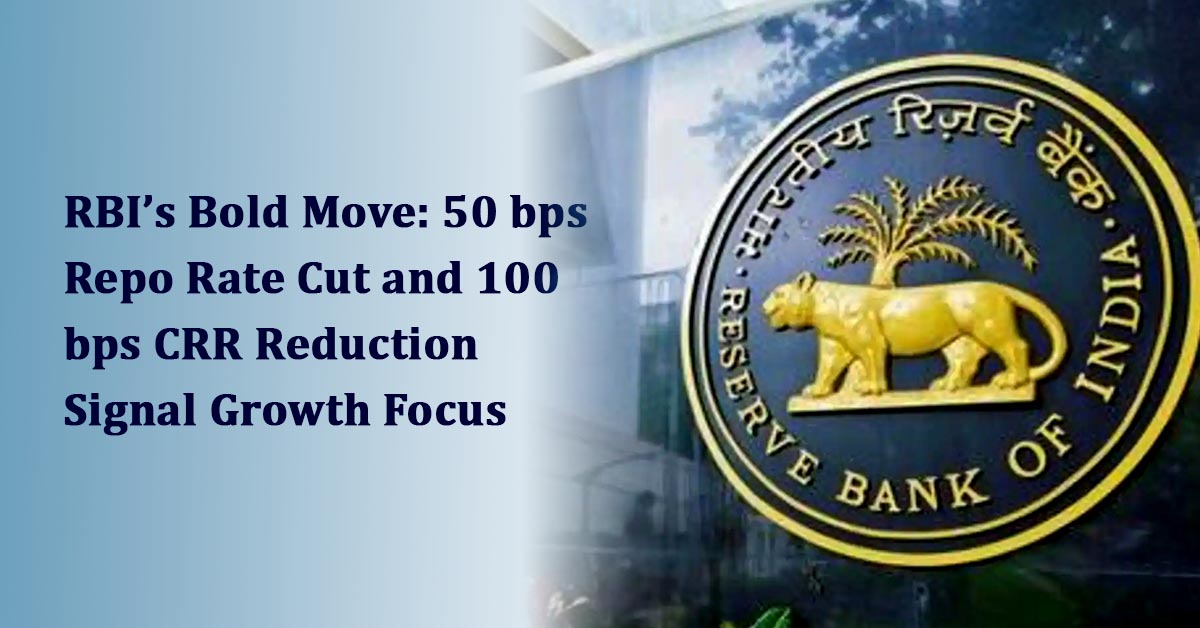
Introduction
In a decisive step that caught markets by surprise, the Reserve Bank of India (RBI) slashed the repo rate by 50
basis points (bps) to 5.50%, marking its third consecutive cut in 2025 and bringing the total reduction to 100
bps this year. Complementing this, the RBI reduced the Cash Reserve Ratio (CRR) by an unexpected 100 bps
and shifted its monetary policy stance from ‘accommodative’ to ‘neutral’. These measures underscore the
central bank’s intent to bolster economic growth while navigating easing inflation pressures, setting the
stage for a dynamic financial landscape.
Key Highlights of the RBI’s Monetary Policy
The RBI’s latest policy announcement reflects a strategic blend of stimulus and stability. Here are the pivotal
points:
1. Repo Rate Reduction: The repo rate was lowered by 50 bps to 5.50%, signalling a continued push to
ease borrowing costs and spur economic activity.
2. GDP Growth Outlook: The RBI retained its fiscal 2026 GDP growth forecast at 6.5%. Quarterly
projections are set at 6.5% for Q1, 6.7% for Q2, 6.6% for Q3, and 6.3% for Q4, reflecting confidence
in sustained economic momentum.
3. CPI Inflation Revision: Inflation projections for FY26 were revised downward to 3.7% from 4%
estimated in April 2025. Quarterly CPI estimates are now 2.9% for Q1 (down from 3.6%), 3.4% for Q2
(from 3.9%), 3.9% for Q3, and 4.4% for Q4, indicating a softening inflationary environment.
4. CRR Cut: The CRR was reduced by 100 bps from 4% to 3%, to be implemented in four staggered
stages, as announced by RBI Governor Sanjay Malhotra. This move will inject ₹2.5 lakh crore in
liquidity, lowering banks’ funding costs and enhancing lending capacity.
5. Economic Insights: Governor Malhotra emphasized robust economic fundamentals, noting that
“rural demand remains steady while urban demand is improving,” underpinned by stable
consumption trends. He highlighted a revival in investment activity, fuelled by strong merchandise
exports in April and sustained growth in services exports. These factors, Malhotra stated, are driving
a broad-based recovery, reinforcing confidence in India’s growth outlook amid economic challenges
and supportive monetary policy.
Implications for the Economy
The RBI’s bold policy actions carry significant ramifications for various stakeholders:
Borrowers: Lower lending rates are likely to follow, reducing equated monthly instalments (EMIs) for
home, auto, and personal loans. This could stimulate consumer spending, a critical driver of
economic growth, particularly in urban markets.
Investors: Equity markets may rally in response to enhanced liquidity and lower borrowing costs,
favoring sectors like real estate and consumer goods. However, fixed-income investors might face
compressed returns as bond yields adjust to the rate cut, prompting a reassessment of portfolio
strategies.
Banks: The CRR reduction will ease liquidity constraints, enabling banks to expand lending activities.
While this may narrow net interest margins in the short term, increased loan demand could offset
the impact, fostering a virtuous cycle of credit and economic activity.
Conclusion
The RBI’s unexpected 50 bps repo rate cut, coupled with a substantial 100 bps CRR reduction, signals a
proactive commitment to economic growth while continuing to keep inflation in check. By boosting liquidity
and easing borrowing costs, these measures are poised to invigorate investment, consumption, and lending
across sectors. For investors and borrowers, this policy shift opens new opportunities to align with India’s
evolving growth narrative, reinforcing the pivotal role of Financial Planning India in these dynamic times.
| Policy Instrument | Previous Rate | Revised Rate | Change |
| Repo Rate | 6.00% | 5.50% | ↓ 50 bps |
| Standing Deposit Facility (SDF) | 5.75% | 5.25% | ↓ 50 bps |
| Marginal Standing Facility (MSF) | 6.25% | 5.75% | ↓ 50 bps |
| Cash Reserve Ratio (CRR) | 4.50% | 3.50% | ↓ 100 bps |
| Statutory Liquidity Ratio (SLR) | 18.00% | 18.00% | No change |
| Policy Stance | Accommodative | Neutral | changed |
